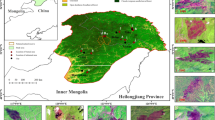Abstract
The point-centered-quarter (PCQ) method has been applied in community analysis since the publication of the method nearly 50 years ago. This and other distance methods offer increased sampling efficiency over fixed-area plots (FAP), but have long been known to produce biased density estimates when plant distribution deviates from random spatial patterns. Spatial indices have been developed to quantify the direction of this bias when plant distributions are aggregated or evenly distributed. Its continued use, especially in community analysis, requires additional scrutiny in measurements of community structure. We measured 14 forest stands of varying age, elevation and disturbance regime using FAP and PCQ methods. Density estimates were biased, with the point-centered quarter method lower than fixed-area plot estimates when stems were aggregated and higher when stems were evenly spaced. In general the PCQ method underestimated species richness. The efficiency of the PCQ method makes it popular for ordination studies, although comparison of community structure varied from 18% to 90% similarity between the measurements of species basal area in the same stands using the two different methods. The bias observed in calculations of stem density, species abundance and community similarity indicate that use of the PCQ method should be approached with caution when used in community level analysis.
Similar content being viewed by others
References
Barbour M.G., Burk J.H. and Pitts W.D. 1987. Terrestrial Plant Ecology, 2nd edition. Benjamin/Cummings, Menlo Park, California, USA.
Bormann F.H. 1953. The statistical efficiency of sample plot size and shape in forest ecology. Ecology 34: 474–487.
Clark D.F. and Evans F.C. 1954. Distance to nearest neighbor as a measure of spatial relationships in populations. Ecology 35: 445–453.
Cottam G. and Curtis J.T. 1956. The use of distance measures in phytosciological sampling. Ecology 37: 451–460.
Dale M.R.T. 1999. Spatial Pattern Analysis in plant ecology. Cambridge Univ. Press, Cambridge, UK.
Davis J.C. 1986. Statistics and Data Analysis in Geology. Wiley, New York, USA.
Diggle P.J. 1977. The detection of random heterogeneity in plant populations. Biometrics 33: 390–394.
Dixon P.M. 2001. The Bootstrap and the Jackknife: Describing the precision of ecological indices, pp. 267–288. In: Sceiner S.M. and Gurevitch J. (eds), Design and Analysis of Ecological Experiements. Oxford University Press, New York, USA.
Efron B. and Tibshirani R.J. 1993. An Introduction to the Bootstrap. Chapman and Hall, New York, USA.
Good R.E. and Good N.F. 1971. Vegetation of a Minnesota prairie and a comparison of methods. American Midland Naturalist 85: 228–231.
Jongman R.H.G., Braak C.J.F. t. and Tongeren O.F.R. v. 1995. Data Analysis in Community and Landscape Ecology, 2nd edition. Cambridge University Press, Cambridge, UK.
Lindsey A.A., Barton J.D. and Miles S.R. 1958. Field efficiencies of forest sampling methods. Ecology 39: 428–444.
Mueller-Dombois D. and Ellenberg H. 1986. Aims and Methods of Vegetation Ecology, 2nd edition. Wiley and Sons, New York, USA.
Pielou E.C. 1959. The use of point-to-plant distances in the study of the pattern of plant populations. Journal of Ecology 47: 607–613.
Pielou E.C. 1977. An Introduction to Mathematical Ecology. Wiley-Interscience, New York, USA.
Risser P.G. and P.H. Zedler 1968. An evaluation of the grassland quarter method. Ecology 49: 1006–1009.
Sokal R.R. and Rohlf F.J. 1995. Biometry: The principles and pratice of statistics in biological research, 3rd edition. W. H. Freeman and Co., New York, USA.
Vincent P.J., Haworth J.M., Griffith J.G. and Collins R. 1976. The detection of randomness in plant patterns. Journal of Biogeography 3: 373–380.
Whittaker R.H. 1982. Ordination of Plant Communities. Dr. W. Junk, Boston, USA.
Author information
Authors and Affiliations
Corresponding author
Rights and permissions
About this article
Cite this article
Bryant, D.M., Ducey, M.J., Innes, J.C. et al. Forest community analysis and the point-centered quarter method. Plant Ecol 175, 193–203 (2005). https://doi.org/10.1007/s11258-005-0013-0
Received:
Accepted:
Issue Date:
DOI: https://doi.org/10.1007/s11258-005-0013-0




